Warning: pic heavy, as usual. 

Specifications:
For those not familiar with the Mini family, check out my earlier Mini 123/AA, Mini CR2, and Mini Tint Comparison reviews.



The light comes in fairly typical 4Sevens packaging. Inside the thin cardboard case with plastic insert is the light, wrist lanyard, spare o-rings, two Duracell AA batteries, manual and warranty card.

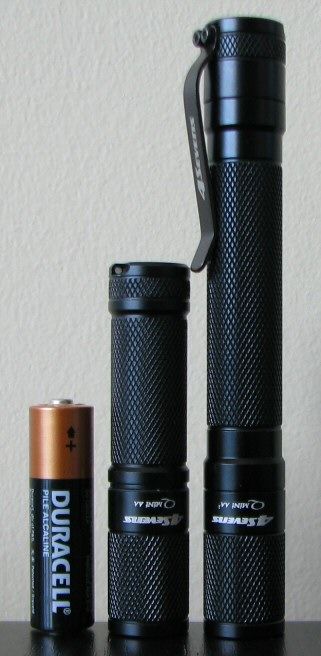
From left to right: Duracell alkaline AA, Quark Mini AA, Mini AA-2

From left to right: Duracell alkaline AA, 4Sevens Quark Mini AA-2, Lumapower Connexion 2AA, 4Sevens Quark AA-2, Fenix LD20-R4, Eagletac P20A2-II, Nitecore D20.
4Sevens Quark Mini AA-2: Weight: 27.7g , Length 131.8mm x Width 17.6mm (bezel)
4Sevens Quark AA-2: Weight 60.7g, Length 147.0mm, Width (bezel) 22.0mm
Eagletac P20A2-II: Weight 85.5g, Length 161.7mm x Width 25.8mm (bezel max)
LF3XT 2AA: Weight: 114.8g, Length x Width: 150.5mm x 25.0mm (max width)
Nitecore D20: Weight: 109.3g, Length: 154.0mm x Width: 25.0mm (head)
The pictures – and numbers – speak for themselves: The Mini AA-2 is by far the smallest and lightest 2xAA light I've tested. oo: And no, that weight is not a misprint - the Mini AA-2 actually weighs less than most 1xAA lights!
oo: And no, that weight is not a misprint - the Mini AA-2 actually weighs less than most 1xAA lights!
 ]
]

In keeping with its twisty status, screw threads are anodized for lock-out (i.e. tighten to turn on). I had noticed a fair amount of thread play on my early Mini AA and Mini 123 samples, and the AA-2 suffers from this as well (although this particular sample feels "tighter" than most of my other ones).
The Minis have the advantage of generous knurling, which makes it easier to use the twist feature one-handed. :thumbsup: Knurling is fairly aggressive. Lettering is sharp and clear, in bright white against the shiny black finish (type III hard anodizing). No chips or flaws on my sample.
Light can tailstand.
Note the addition of the 4Sevens clip, which is new for the AA-2 model. I like it, as it feels more secure than most clips in this class of light. You would need a fine-tip screwdriver to remove.
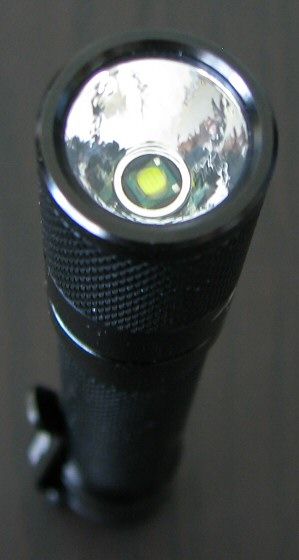

4Sevens went with the latest emitter (XP-G R5) for the all members of Mini line, including the AA-2. Reflector is the common shallow light orange peel (LOP). Note that the head of the AA-2 looks exactly the same as the AA head. You should expect the exact same beam pattern.
Which brings us to the requisite white wall hunting . All lights are on Hi on Sanyo Eneloop AA, about ~1 meter from a white wall.
. All lights are on Hi on Sanyo Eneloop AA, about ~1 meter from a white wall.
Sorry for the quality of the white wall beamshots – I've recently moved, and haven't had a chance to set up a proper beamshot closet yet. What you are looking at below is recently primed drywall.

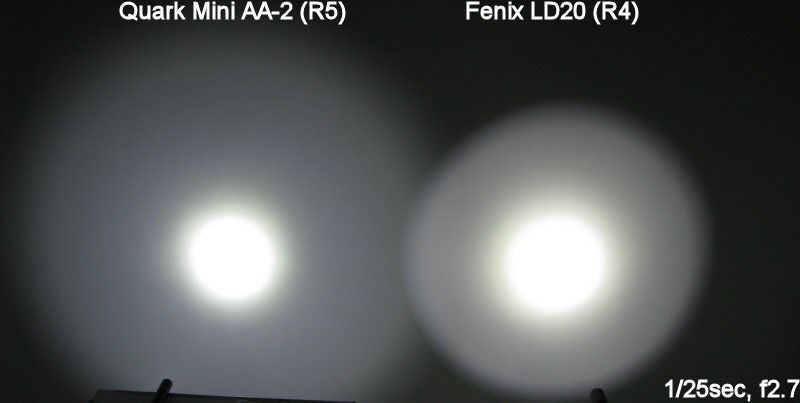



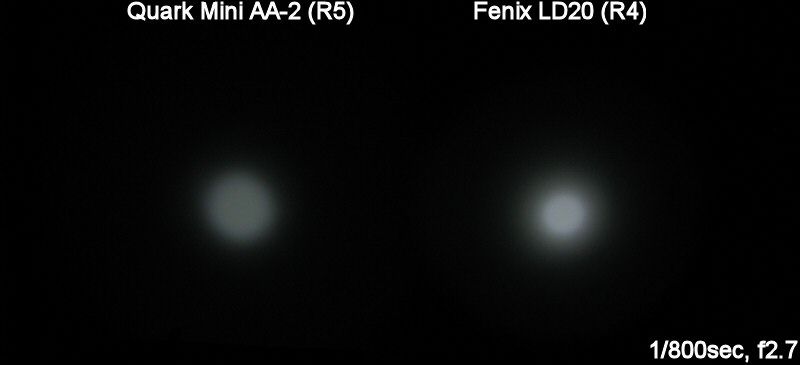


As expected for a XP-G emitter in a shallow reflector, the light has a wide spillbeam with reduced throw (compared to most other lights).
Again, the Mini AA-2 beam pattern is exactly the same as the earlier Mini AA (same head dimensions). However, the AA-2 max output is a lot higher (beam comparison not shown – scroll down to the runtimes for some numbers).
User Interface
The Mini AA-2 uses the same interface as the earlier Mini AA and Mini 123 – which is in turn the same as the original 1xAAA Preons (the new 1xAAA Preon ReVo is slightly revised).
Basic operation is controlled by twisting the head tight against the body to activate the light, loosen to turn off. Do a twist off-on in under 1 sec and the light advances to its next mode in this order: Lo > Med > Hi mode. Wait more than two seconds before re-activating the light after turning off, and it returns to default Lo (i.e. no memory mode).
There is no strobe or SOS mode to worry about in the regular interface, they are "hidden" away if you want them. To access, complete the Lo-Med-Hi twist sequence twice in under two seconds (i.e. Lo > Med > Hi > Lo > Med > Hi). The additional modes then present themselves in sequence as Strobe > SOS > Hi Beacon > Lo Beacon (twist off-on to activate each in sequence).
Note that there is no memory for "special outputs" either – if you turn off the light for more than 2 seconds, you will be back at constant output Lo when next you re-illuminate. So no worries about getting stuck accidentally strobing yourself here. :thumbsup:
PWM and Strobe
Med

Lo

Like all the earlier Mini and Preon lights, pulse-width-modulation (PWM) is used for the Lo/Med modes. PWM frequency is unchanged at a reasonably high 2.42 kHz across the line (i.e. you won't notice it in use).

Again, strobe remains ~10Hz across the Mini/Preon lines.
Beacon modes are 5 rapid flashes followed a single flash at 10 sec intervals, at either full power (Hi) or lower power (Lo).
Testing Method: All my output numbers are relative for my home-made light box setup, a la Quickbeam's flashlightreviews.com method. You can directly compare all my relative output values from different reviews - i.e. an output value of "10" in one graph is the same as "10" in another. All runtimes are done under a cooling fan, except for the extended run Lo/Min modes (i.e. >12 hours) which are done without cooling.
Throw values are the square-root of lux measurements taken at 1 meter from the lens, using a light meter.
Throw/Output Summary Chart:

Output/Runtime Comparison:

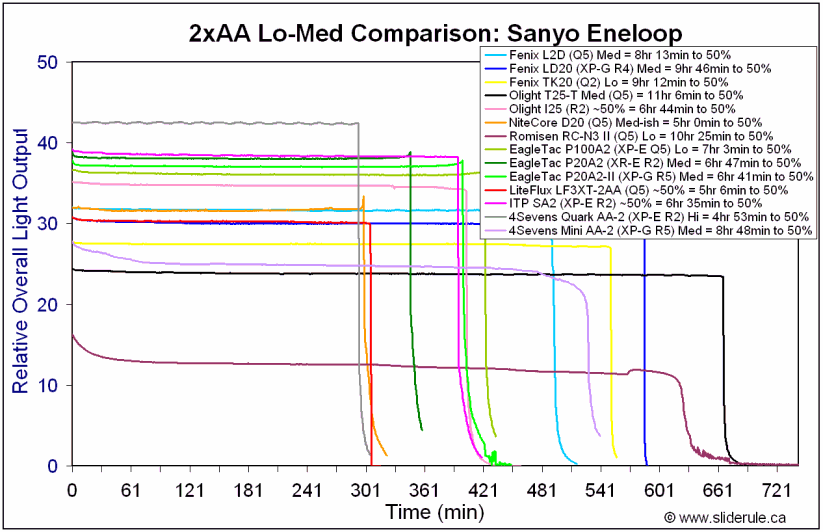

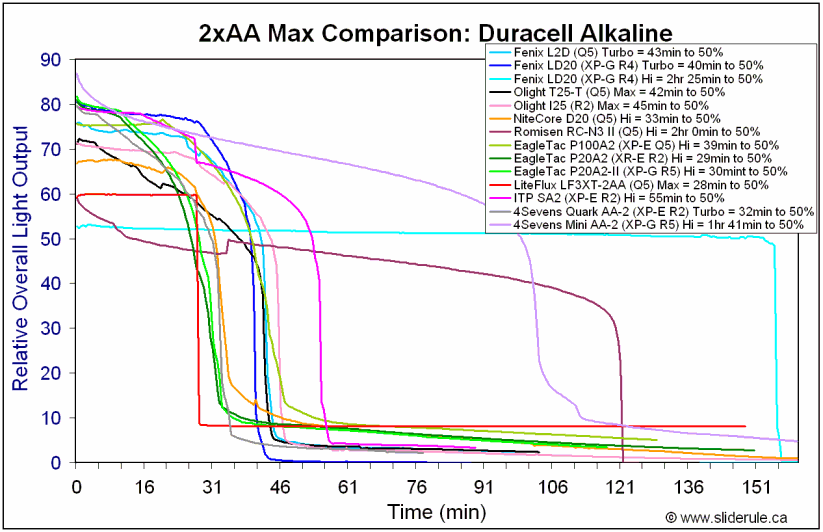

The Mini AA-2 has incredibly good runtime for the output on its Hi setting. oo:
oo:
Unfortunately, overall efficiency on the Med level is somewhat below average for this class of light. This is likely due to the less efficient PWM method for reducing output – it doesn't really compare to the current-controlled lights (e.g. regular 4Sevens Quark, Fenix, Olight, Eagletac). However, the higher output bin R5 at least puts overall runtime performance within an acceptable range.
But I imagine a lot of people would like to know how it compares directly to the 1xAA Mini:

Potential Issues
Body wall construction is fairly thin, in keeping with the ultra-light build. As with the other member of this Mini family, I suggest you be mindful of this when handling.
There can be some play in the threads for all members of the Mini line (which can lead to accidental mode switching by pressing the head). Although my AA-2 sample seems better than most of my earlier single-cell Mini lights, it is hard to tell from one sample.
Preliminary Observations
The 1xCR2/CR123A/AA Minis have carved out a nice little niche for themselves in the ultra-light market of lights (sorry for the pun ). Certainly, the user interface and build are remarkably similar to this 2xAA version (e.g. the heads look the same, act the same). All the positives I pointed out in my Mini AA/123 review apply here as well. There's also the addition of a new, good quality pocket clip on the 2xAA build. :thumbsup:
). Certainly, the user interface and build are remarkably similar to this 2xAA version (e.g. the heads look the same, act the same). All the positives I pointed out in my Mini AA/123 review apply here as well. There's also the addition of a new, good quality pocket clip on the 2xAA build. :thumbsup:
But do people really need want/need an ultra-light 2xAA light? For most non-flashaholics, I typically recommend a standard length/weight 2xAA light, with multiple modes and a clicky switch. But users in the ultra-light world (e.g. travelers, backpackers, etc) look at things a little differently. For them, the emphasis is on performance for the size, with reliability and ease of use as key criteria (e.g. twisties typically preferred, as clickies can break on the road, etc).
Looking at it through that lens, the question really becomes: is there a performance advantage for the extra size/weight of a second cell? To answer that, I suggest you take a look at the Mini AA and AA-2 output/runtime comparison graph.
As you'll see, the Mini AA-2 has exactly the same runtime on Hi as the Mini AA – but with at least twice the output. I suspect this is what a lot of users like to see on Hi – twice the output for the extra weight of carrying two cells. :thumbsup:
But what about Med and Lo? As my Med results show, both output and runtime are increased on the Med mode the AA-2 (i.e. output is only partially increased, giving some runtime advantage as well). I haven't test Lo, but as the output levels are nearly identical, I would expect quite a bit longer runtime in 2xAA format. :twothumbs
These results are significant, as I don't think there would be as much of a market for the AA-2 if it didn't have an absolute runtime advantage at Med-Lo (i.e. I doubt most ultra-light users could justify the extra size and weight without greater runtime at some levels). As such, I recommend 4Sevens clarify the relative runtime numbers on their website – the currently listed specs don't seem to accurately capture the differences (i.e. the Mini AA runtime specs seem a bit high ).
).
The other possible ultra-light comparator here would the AAA class of lights. Although not available in the same physical build as the Mini, you can get the same circuit and relative performance in the 1xAAA and 2xAAA format as the 4Sevens Preon. But while a lot thinner and lighter, I would caution that AAAs only hold ~1/3 the capacity of AAs.
For its intended use, my main suggestion for the Mini AA-2 would be to improve the relative efficiency of the circuit on Lo/Med modes (only Med tested here). I may have been spoiled by all the current-controlled lights, but I would like to see longer runtime for the output.
But definitely no complaint about the Mini AA-2 performance on Hi – the runtime results are outstanding, on all batteries. oo: I am particularly impressed by the regulation and runtime on standard alkalines (again, while we may eschew them, a lot of the mainstream world still uses 'em).
oo: I am particularly impressed by the regulation and runtime on standard alkalines (again, while we may eschew them, a lot of the mainstream world still uses 'em).
From my perspective, the AA-2 is a successful extension of the Mini line into the dual-cell world. At the various least, it provide another lightweight option for extended runtime and output on standard AA cells.
----
Quark Mini AA-2 was supplied by 4Sevens.com for review.

Specifications:
- LED: CREE XP-G R5
- Material: Type-III hard-anodized aircraft-grade aluminum
- Lens: Optical-grade glass lens with anti-reflective coating on both sides
- Waterproof Rating: IPX-8
- Battery Type: Two AA batteries (up to 3.0 volts combined; batteries are included)
- Seven Output Modes:
- Low: 3.0 OTF lumens, 3.4 days
- Medium: 36 OTF lumens, 8.8 hours
- High: 180 OTF lumens, 1.7 hours
- Strobe: 3.3 hours
- S.O.S.: 10 hours
- Beacon (Hi): 17 hours
- Beacon (Lo): 88 hours
- Dimensions: Length: 5.0 inches, Diameter: 0.7 inches, Weight: 1.0 ounces
- Ultra compact design
- Secure, deep-carry pocket clip
- Superior reflector for the perfect balance between spot and flood lighting
- Included accessories: Lanyard, spare o-ring, instruction manual, and two AA batteries.
- Estimated MSRP ~$40
For those not familiar with the Mini family, check out my earlier Mini 123/AA, Mini CR2, and Mini Tint Comparison reviews.



The light comes in fairly typical 4Sevens packaging. Inside the thin cardboard case with plastic insert is the light, wrist lanyard, spare o-rings, two Duracell AA batteries, manual and warranty card.


From left to right: Duracell alkaline AA, Quark Mini AA, Mini AA-2

From left to right: Duracell alkaline AA, 4Sevens Quark Mini AA-2, Lumapower Connexion 2AA, 4Sevens Quark AA-2, Fenix LD20-R4, Eagletac P20A2-II, Nitecore D20.
4Sevens Quark Mini AA-2: Weight: 27.7g , Length 131.8mm x Width 17.6mm (bezel)
4Sevens Quark AA-2: Weight 60.7g, Length 147.0mm, Width (bezel) 22.0mm
Eagletac P20A2-II: Weight 85.5g, Length 161.7mm x Width 25.8mm (bezel max)
LF3XT 2AA: Weight: 114.8g, Length x Width: 150.5mm x 25.0mm (max width)
Nitecore D20: Weight: 109.3g, Length: 154.0mm x Width: 25.0mm (head)
The pictures – and numbers – speak for themselves: The Mini AA-2 is by far the smallest and lightest 2xAA light I've tested.


In keeping with its twisty status, screw threads are anodized for lock-out (i.e. tighten to turn on). I had noticed a fair amount of thread play on my early Mini AA and Mini 123 samples, and the AA-2 suffers from this as well (although this particular sample feels "tighter" than most of my other ones).
The Minis have the advantage of generous knurling, which makes it easier to use the twist feature one-handed. :thumbsup: Knurling is fairly aggressive. Lettering is sharp and clear, in bright white against the shiny black finish (type III hard anodizing). No chips or flaws on my sample.
Light can tailstand.
Note the addition of the 4Sevens clip, which is new for the AA-2 model. I like it, as it feels more secure than most clips in this class of light. You would need a fine-tip screwdriver to remove.


4Sevens went with the latest emitter (XP-G R5) for the all members of Mini line, including the AA-2. Reflector is the common shallow light orange peel (LOP). Note that the head of the AA-2 looks exactly the same as the AA head. You should expect the exact same beam pattern.
Which brings us to the requisite white wall hunting
Sorry for the quality of the white wall beamshots – I've recently moved, and haven't had a chance to set up a proper beamshot closet yet. What you are looking at below is recently primed drywall.








As expected for a XP-G emitter in a shallow reflector, the light has a wide spillbeam with reduced throw (compared to most other lights).
Again, the Mini AA-2 beam pattern is exactly the same as the earlier Mini AA (same head dimensions). However, the AA-2 max output is a lot higher (beam comparison not shown – scroll down to the runtimes for some numbers).
User Interface
The Mini AA-2 uses the same interface as the earlier Mini AA and Mini 123 – which is in turn the same as the original 1xAAA Preons (the new 1xAAA Preon ReVo is slightly revised).
Basic operation is controlled by twisting the head tight against the body to activate the light, loosen to turn off. Do a twist off-on in under 1 sec and the light advances to its next mode in this order: Lo > Med > Hi mode. Wait more than two seconds before re-activating the light after turning off, and it returns to default Lo (i.e. no memory mode).
There is no strobe or SOS mode to worry about in the regular interface, they are "hidden" away if you want them. To access, complete the Lo-Med-Hi twist sequence twice in under two seconds (i.e. Lo > Med > Hi > Lo > Med > Hi). The additional modes then present themselves in sequence as Strobe > SOS > Hi Beacon > Lo Beacon (twist off-on to activate each in sequence).
Note that there is no memory for "special outputs" either – if you turn off the light for more than 2 seconds, you will be back at constant output Lo when next you re-illuminate. So no worries about getting stuck accidentally strobing yourself here. :thumbsup:
PWM and Strobe
Med

Lo

Like all the earlier Mini and Preon lights, pulse-width-modulation (PWM) is used for the Lo/Med modes. PWM frequency is unchanged at a reasonably high 2.42 kHz across the line (i.e. you won't notice it in use).

Again, strobe remains ~10Hz across the Mini/Preon lines.
Beacon modes are 5 rapid flashes followed a single flash at 10 sec intervals, at either full power (Hi) or lower power (Lo).
Testing Method: All my output numbers are relative for my home-made light box setup, a la Quickbeam's flashlightreviews.com method. You can directly compare all my relative output values from different reviews - i.e. an output value of "10" in one graph is the same as "10" in another. All runtimes are done under a cooling fan, except for the extended run Lo/Min modes (i.e. >12 hours) which are done without cooling.
Throw values are the square-root of lux measurements taken at 1 meter from the lens, using a light meter.
Throw/Output Summary Chart:

Output/Runtime Comparison:





The Mini AA-2 has incredibly good runtime for the output on its Hi setting.
Unfortunately, overall efficiency on the Med level is somewhat below average for this class of light. This is likely due to the less efficient PWM method for reducing output – it doesn't really compare to the current-controlled lights (e.g. regular 4Sevens Quark, Fenix, Olight, Eagletac). However, the higher output bin R5 at least puts overall runtime performance within an acceptable range.
But I imagine a lot of people would like to know how it compares directly to the 1xAA Mini:

Potential Issues
Body wall construction is fairly thin, in keeping with the ultra-light build. As with the other member of this Mini family, I suggest you be mindful of this when handling.
There can be some play in the threads for all members of the Mini line (which can lead to accidental mode switching by pressing the head). Although my AA-2 sample seems better than most of my earlier single-cell Mini lights, it is hard to tell from one sample.
Preliminary Observations
The 1xCR2/CR123A/AA Minis have carved out a nice little niche for themselves in the ultra-light market of lights (sorry for the pun
But do people really need want/need an ultra-light 2xAA light? For most non-flashaholics, I typically recommend a standard length/weight 2xAA light, with multiple modes and a clicky switch. But users in the ultra-light world (e.g. travelers, backpackers, etc) look at things a little differently. For them, the emphasis is on performance for the size, with reliability and ease of use as key criteria (e.g. twisties typically preferred, as clickies can break on the road, etc).
Looking at it through that lens, the question really becomes: is there a performance advantage for the extra size/weight of a second cell? To answer that, I suggest you take a look at the Mini AA and AA-2 output/runtime comparison graph.
As you'll see, the Mini AA-2 has exactly the same runtime on Hi as the Mini AA – but with at least twice the output. I suspect this is what a lot of users like to see on Hi – twice the output for the extra weight of carrying two cells. :thumbsup:
But what about Med and Lo? As my Med results show, both output and runtime are increased on the Med mode the AA-2 (i.e. output is only partially increased, giving some runtime advantage as well). I haven't test Lo, but as the output levels are nearly identical, I would expect quite a bit longer runtime in 2xAA format. :twothumbs
These results are significant, as I don't think there would be as much of a market for the AA-2 if it didn't have an absolute runtime advantage at Med-Lo (i.e. I doubt most ultra-light users could justify the extra size and weight without greater runtime at some levels). As such, I recommend 4Sevens clarify the relative runtime numbers on their website – the currently listed specs don't seem to accurately capture the differences (i.e. the Mini AA runtime specs seem a bit high
The other possible ultra-light comparator here would the AAA class of lights. Although not available in the same physical build as the Mini, you can get the same circuit and relative performance in the 1xAAA and 2xAAA format as the 4Sevens Preon. But while a lot thinner and lighter, I would caution that AAAs only hold ~1/3 the capacity of AAs.
For its intended use, my main suggestion for the Mini AA-2 would be to improve the relative efficiency of the circuit on Lo/Med modes (only Med tested here). I may have been spoiled by all the current-controlled lights, but I would like to see longer runtime for the output.
But definitely no complaint about the Mini AA-2 performance on Hi – the runtime results are outstanding, on all batteries.
From my perspective, the AA-2 is a successful extension of the Mini line into the dual-cell world. At the various least, it provide another lightweight option for extended runtime and output on standard AA cells.
----
Quark Mini AA-2 was supplied by 4Sevens.com for review.
Last edited:





